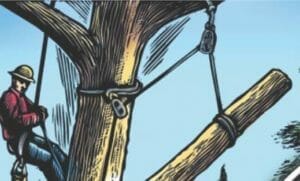When most of us think about environmental hazards, our minds are drawn to the weather (floods, storms, etc). But often, that  weather is part of what causes a less-thought-of danger: falling trees.
weather is part of what causes a less-thought-of danger: falling trees.
Trees do way much more good than bad, but if not looked after, they can also cause serious damage when branches or whole tree falls on homes, power lines, cars, or people.
Fortunately, there are warning signs you can look for that show danger may be imminent. Start by inspecting each tree on your property in a very systematic way. Here are some things to look for:
Start at the top. Trees that have been topped (the top is cut off) present dangers in several ways. First, topped trees are more susceptible to diseases that can weaken them. They are also prone to being top heavy because of excessive crown regrowth and weakly attached upper branches.
A dead tree or branches. One of the more common situations to arise is dead trees or branches. They are generally the most immediate danger and should be removed immediately. Pay particular attention after nasty weather, when branches may be broken and ready to fall at any time. (See why tree removal is not a good DIY project.)
Insects and disease. These can also lead to serious tree hazards. While an arborist is better suited for identifying the specific insect or disease that is causing a problem, an attentive amateur can at least notice there is a problem.
While some diseases cause internal rot that is invisible to the naked eye, often evidence will be displayed through the presence of mushrooms, which may be a sign of decay-causing fungi. Other times, the problem can be clearly seen via rotted wood or even a cavity in the tree. While not every hole is a big risk, you don’t have to be a certified arborist to suspect that this could compromise the tree’s structural integrity.
Look for growth patterns. Even just how a tree is growing naturally can spell trouble. For instance, codominant trunks or branches (trunks that are parallel to one another or branches formed at an acute angle) can become a problem. Codominant branches can form what’s called “included bark” which forms between the two branches. This weakens the area where they come together.
While this doesn’t include every sign you can look for that you have a tree hazard, if you can begin to recognize many of the warning signs and know when you need to take action, you can reduce the risks to you, your family, and to anyone else who may come within reach of the trees on your property.